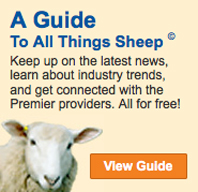
AMERICAN LAMB BOARD RECIPE
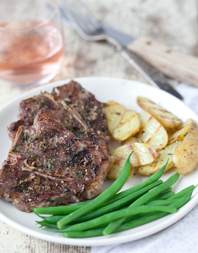 Grilled American Lamb Loin Chops with 6 Spices
Grilled American Lamb Loin Chops with 6 Spices
4 servings
Preparation time: 30 minutes
Cook time: 12 minutes
4 American Lamb loin chops
Bring chops to room temperature (at least 30 minutes out of the refrigerator) before grilling.
Spice Rub
1 tablespoon whole coriander seeds
1 tablespoon fennel seeds
1 tablespoon fresh thyme leaves
1-1/2 teaspoons black peppercorns
1-1/2 teaspoons smoked salt
1 bay leaf
In a spice grinder (or coffee grinder), grind coriander, fennel, thyme, peppercorns, salt and bay leaf until fine. Sprinkle spice rub over lamb chops.
Preheat grill to medium-high. Grill chops for approximately 4 to 6 minutes per side. For medium-rare, remove lamb chops from heat when thermometer registers between 130°F and 135°F (or to desired doneness), being careful not to burn spice rub. Rest chops, lightly covered, for at least 10 minutes before serving.
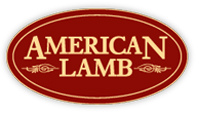 Recipe and image provided by the American Lamb Board. Remember, sign up (located on the right side, top or bottom of home page) for their "Recipe Newsletter".
Recipe and image provided by the American Lamb Board. Remember, sign up (located on the right side, top or bottom of home page) for their "Recipe Newsletter".
Also, see more lamb recipes on our Guide
MOTHER EARTH NEWS FAIR
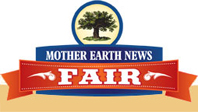 Visit us at
Visit us at
Mother Earth News Fair
Premier's booth #6604 & 6605
Asheville, NC
April 12-13, 2014
Premier's booth #1221 & 1320
Puyallup, WA
May 31-June 1, 2014
Premier's booth #151 & 153
Seven Springs, PA
September 12-14, 2014
Premier's booth #TBA
Topeka, KS
October 25-26, 2014
SHED LAMBING TOOLS
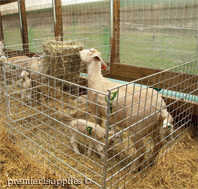
Wire panels are used to build lambing jugs in our lambing barn. Panels are connected via wire hinges and snap clips.
Wire panels for
lambing jugs
Select height:
| • |
PowerBilt® Panels, 36" or 48" |
| • |
Welded Wire Panels, 40" |
Choose according to your animals’ behavior (wild vs relaxed, athletic vs calm) and your preferences (tall vs short). We use connector hinges or braided nylon cord to tie jugs together and Snap Clips as latches.
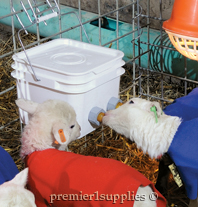
Feeding orphan lambs with the 2 gal square bucket. If feeding in warmer months, use the 4 gal bucket and place a frozen water bottle in it to keep the milk cool.
Square Buckets
Ideal for use as bucket teat units. Flat sides sit against panel, reducing the likelihood of being knocked around by assertive lambs. Hang with Premier Bucket Holder.
See our "How to Video".
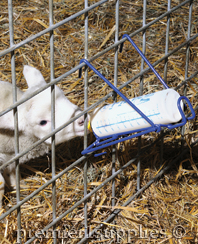
Bottle rack conveniently and securely fits on the outside of a lambing jug or orphan pen.
Bottle Rack
Clever Premier innovation allows new lambs to self-feed from our Lamb ‘N’ Kid Bottle (sold separately).
See our "How to Video".
|
 |
 |
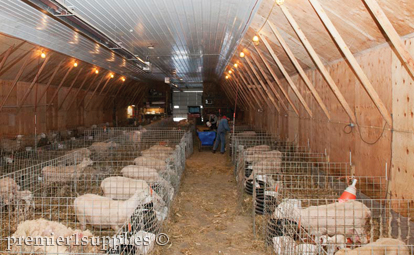
Overview of the barn. We don't like the design (it was built 20 years ago and has been modified many times) but we had it so we're using it. Heated in the winter by infrared propane heaters in the ceiling. We use Premier heat lamps only when the lambs are small (triplets and quads). Next year we will use LED lights instead of incandescant because the light is better for both animals and humans-and they are much cheaper to operate.
Premier's Unique Lambing System
Most shed (indoor) lambing systems allow the ewes to lamb in small groups (20-40 head). The area is called a drop pen, which may or may not be under a roof. As soon as the ewes lamb the shepherd picks up the lamb(s) and leads the ewe into an individual pen (jug). They remain there for 1-4 days until the lambs are docked, castrated and ear-tagged. The next stop is a mothering-on pen that mixes several (10-40) ewes and lambs together.
The negatives of this system are:
1. Without 24/7 attention, mismothering occurs when multiple ewes lamb between checks—and sorting out the confusion is frustrating for both sheep and shepherd. But more frequent checks means lost sleep, grumpy shepherds, etc. Net result: The flock is in control of the shepherd (instead of the opposite).
2. When it's winter in the northern USA, hypothermia can kill newborns in chilly drop pens. It's much worse when snow, ice or cold rain occurs and there isn't a roof over the pens. A solution is more frequent checks (lost sleep again) and heat lamps—but that's extra time per sheep. Net result: The situation, yet again, is controlling the shepherd.
3. Not all ewes are willing to leave the lambing site and follow the shepherd and newborns into a jug. There are many things more fun than being alone at midnight on a subzero night in poor lighting trying to persuade a reluctant ewe or ewe lamb to leave her drop spot and follow you and her lambs.
4. If a ewe experiences lambing difficulty (dystocia), then job #1 is catching the problem ewe. In drop pens this is an athletic challenge—because 4 legs are quicker than 2 legs. It helps if you have a good crook, sheep genetics with small flight zones and a strong, young upper body. As the years pass I've noticed that I'm keen to prevent these situations. Lightweight portable gates help.
We tried pasture lambing but it also had negatives for us:
1. Coyotes. They're feeding pups in May—so they have extra reasons to challenge canine and electric fence defenses.
2. Internal parasites. We have few "clean" pastures—even in early spring. Millions of worm larva/acre on the fresh, green grass can be life-threatening for lambs and lactating ewes.
3. External parasites. Iowa's flies and gnats consider wounds from tagging, docking and castration to be excellent food sources.
4. Southeast Iowa's hot, humid summer weather reduces a lamb's rate of gain. It can add 50% to the time from birth to slaughter.
5. Reduced conception rates—because we have to breed in December to lamb in May. For our wool ewes the difference is 40 fewer lambs per 100 ewes.
6. Mismothering. Also occurs on pasture when the stocking rate is high and prolific ewes cluster under trees in May to shelter from the hot sun, flies and/or rain.
7. Freezing rain. I'm trying to forget picking up so many dead lambs after a 48-hour event during lambing in spring 2012.
8. Dystocia. Unless you have an unusually good dog, the future of the ewe (and her lambs) is grim by the time she's willing to let you catch her with a crook.
So we decided to try something different in 2013 that would allow us to sleep through the night(s) and still avoid most of the problems noted above. We’ve repeated it, with variations, for 2014:
1. We strive to lamb 50 ewes/week from Dec. 20 through May 15. The way to achieve this, obviously, is to exercise tight control of the rams. We expose up to 200 ewes to rams with marking harnesses from July 25 onward. As soon as 50 ewes have been marked we pull the rams out. Seven days after the first exposure the rams go back in—and so on.
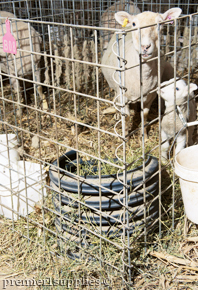
Corner of a lambing jug. Note the water and grain buckets (white). The hay feeder (made from a drainage pipe) has not been a good solution for feeding hay. We're working on a better one. Jugs are made of Premier's wire panels. We prefer the panels with 3" x 3" holes to these 4" x 4" holes-but we had these on hand). They are held together with Premier's wire connectors. The "B08" ear tag is the number of the jug. Ewe has a yellow RFID ear tag and purple visual tag.
|
2. After 6 weeks we leave a week open (no breeding) and again at 13 weeks—to give us time to take down the jugs and clean out the lambing area with a skid steer. (We have a heated and insulated barn, which we keep at 40°F all winter, with a concrete floor. This building was a product warehouse from 2000 to 2012.)
3. In the barn we install 90 jugs in 4 rows separated by two 6 ft aisles. The jugs are 4 x 6 ft. (We think 5 x 5 ft might be better.) It’s critical that the jugs can be taken apart and reinstalled rapidly because it's necessary to clean out the barn twice over the 20-week lambing period. The jugs are made of Premier welded wire panels held together with wire connector hinges.
4. We jug the ewes just prior to lambing. We use the breeding date plus 144 days and udder development to tell us when to do so. Regrettably, it's not precise. The ewes stay in the jug until they lamb. Length of time in the jug can vary from 3 to 10 days. Sometimes 70 ewes lamb a week and sometimes 30. That's why we need 90 jugs for 50 ewes/week.
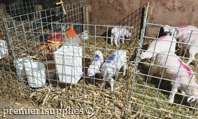
Our orphan lambs are kept in lambing jugs organized by the age. 5-6 week old lambs on right (with red stripe) have recently been weaned off of milk replacer. Bedding is unground corn stalks.
|
5. Water? Supplied to each ewe in 1 gal buckets hung to the side of the jug. To fill the buckets, we load a cart with water and roll it around the aisles, refilling the buckets over the side of the jug.
6. Feed? We load a cart with enough soy hulls, DDGS, etc. for the ewes and roll it around the aisles. It's fed to each ewe in a Premier 2 gal square bucket placed in the jug. We adjust the feed to match the ewe's condition, number of lambs, etc.
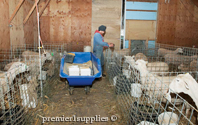
Feeding ewes in jugs soybean hulls and DDGS (dried distillers grains) from a rolling cart. Takes time but it's not hard work. Feeding this way allows shepherd to see which sheep are happy and which are not.
|
7. Hay is fed in a 1.5 ft diameter black drainage tile set on end. (It's not a good system.) We cut square bales into smaller chunks with a chain saw.
8. Bedding? We've tried wheat straw (ground and unground), corn stalks (ground and unground) and wood from shredded pallets. Ground corn stalks have proved to be the best for us.
9. Time? It takes us 3 hrs/day (90 minutes AM and PM) to check, iodine navels of any newborns, feed, water and re-bed 80 ewes in the jugs. That's 2.5 minutes/ewe/day. More than we would like. We think we can cut this to 1.5 minutes next year.
We don't check the sheep after 9 pm or before 6 pm. (I do these checks because the barn is a stone's throw from my house.) If I'm not home the ewes aren't checked from 5 pm to 8 am. And that's the core and principle reason we developed this system—to allow sheep producers to live normal lives while their sheep are lambing—to sleep, go to work at a day job, attend social events, etc. The sheep are no longer controlling the shepherd.
| • |
Hypothermia doesn't occur. The barn is heated. |
| • |
Neither does mismothering. Ewe-to-lamb bonds are instant and not confused by other lambs and ewes. |
| • |
Dystocia, when it occurs, is easy to address. The ewe is alone in a small pen and therefore very easy to catch. |
| • |
When lambs appear we put iodine on the navels and record the date, pen and number of lambs. We don't step into the jug with the newborns. Instead we snag the lambs from outside with a neck crook. |
| • |
We rarely (less than 1%) help any lambs to nurse. Much of this is due to genetics with high "livability." |
| • |
We do "tube" small or weak lambs (usually a triplet or quad). And we do supplement some of these with milk replacer for a few days until the ewe can manage on her own. |
| • |
We leave most triplets with the ewe. We only orphan lambs from ewes that die, ewes that have a bad udder, a quad or lambs that the mother rejects (usually for having very sharp teeth at birth). |
| • |
It's a very nice sensation to check the ewes for lambs while walking down sheep-free aisles @ 40°F when it's 15° outside! |
After 3 months and 1400 lambs from 550 Dorper/Romanov/Katahdin and 90 Border Leicester/Ile de France ewes?
| • |
Lamb loss rate from live ewes for any cause (inclusive of stillbirths) for hair ewes has been 5% and for wool ewes 8% (lambs less vigorous; our feed quality was part of the problem). |
| • |
Assisted less than 5% of the ewes to lamb. |
| • |
Had 12 ewes with hypocalcaemia (new for us). Most died. Once we corrected the feeding system it never occurred again. |
| • |
No pneumonia. |
| • |
Had 5 lambs with E. coli/watery mouth in late March. Lambs from our hair ewes were active enough that they nurse quickly on their own and therefore did not experience any E. coli. Lambs from our wool ewes, particularly lambs from a few very thin ones that had 3 lambs, were much less keen to nurse—which predisposed them to E. coli problems. |
| • |
A percentage of our wool lambs still experience entropion. Our hair lambs never do. It comes from purchasing rams with this problem a few years ago. We're culling for it. |
| • |
28 orphan lambs. We lost 4. All others doing very well. |
The negatives:
| • |
Though it doesn't take more bedding and feed for sheep that lamb in jugs vs a grouped drop pen, it is probably more work/ewe and /lamb. |
| • |
It's more work/ewe than pasture lambing. |
| • |
In winter, it’s more $$, obviously, to feed lactating ewes and lambs than it is to feed dry ewes that will lamb on pasture in May |
| • |
The investment for the building, jugs, heat, carts and buckets is higher than for pasture lambing. |
What might we do differently next year?
1. Nipple waterers in each jug so we don't have to haul water.
2. A larger cart to carry bedding around the aisles.
3. Better hay feeders.
4. Use more terminal sires—to increase muscling and raise slaughter weights.
5. Breed our hair ewes to begin lambing Dec. 1.
Do we recommend this system—and for whom?
| • |
For those who happen to already have an insulated, heated building—as we did! However, based on 2 years of experience, if we had not had one, we would build or modify a building for this. |
| • |
For those who want to lamb more than 50 ewes in the winter and would like to check lambing ewes only twice a day because they have another job and/or want to sleep through the night. |
| • |
For those with a costly pasture-lambing problem because of coyotes, parasites and/or heat—but still want to keep sheep on their property. |
| • |
For those who want to lamb ewes more than once/year. |
Warm spring rains will soon be coming through to awaken our pastures. The overnight change from dull brown to bright green will have us setting up netting left and right so we can get our flocks out of the barns and feedlots and back to grazing pastures.
Check out our electric netting and solar energizer options.
|
2013 ANNUAL SHEEP INDUSTRY REVIEW
Executive Summary
Prepared by the American Sheep Industry Association for the American Lamb Board, March 2014
2013 was a year of transition and promise for the U.S. sheep industry. Lamb prices started the year sluggish, with minimal early-year gains and little promise of recovery. By late summer, however, a turning point occurred. The industry had produced an excellent, current lamb offering through the year and feedlot supplies were low. Prices began to rise sharply.
The industry was poised for a fall run unlike we’ve seen before. Typically the largest volumes of feeders trade in early fall, but with a corresponding depression in prices. This year, feeders traded in droves yet prices strengthened. In September alone, over 83,000 feeders moved in direct trade, 40-percent higher year-on-year and 72-percent higher than its 5-year average for the month. Lower corn prices and tight inventory fueled higher feeder lamb prices. By the end of 2013, feeder lamb prices saw an 73-percent jump from the year’s low in July. Higher feeder lamb prices and the upcoming December holidays pushed auction slaughter lamb prices higher, up 39 percent from the year’s low.
As feeder and slaughter lamb prices charged upward in late 2013, there was some concern that the 18-percent gain in the meat market was not keeping pace. Would there be repercussions whereby packer lamb purchases slowed and slaughter and feeder lamb prices crashed?
Read More »
LAMB ILLNESS
Spider Syndrome
Gerald Q. Fitch, Extension Sheep Specialist, Oklahoma Cooperative Extension Service
Spider Syndrome is a genetic problem, common in the Suffolk breed and becoming more common in the Hampshire breed. Spider syndrome has been compared to dwarfism in beef cattle so prevalent in the 1950s. Spider syndrome has also been diagnosed in commercial flocks that keep brockle-faced lambs back as replacement ewes. Those ewes are coming from Suffolk or Hampshire rams that carry the syndrome. Researchers feel certain that spider syndrome is caused by a simple, autosomal, recessive gene. If a producer has a flock of carrier ewes and breeds them to a carrier ram, one-fourth of his or her lamb crop could be spiders!!!
Diagnosis
Spider lambs are affected in one of two ways: 1) lambs are abnormal at birth and will probably never be able to stand, or 2) lambs appear normal at birth, but develop into a spider lamb at two to six weeks of age. Spider lambs usually have abnormal bone and cartilage growth. Affected lambs commonly develop an outward deviation of the front legs below the knee, this may also be present in the rear legs below the hock. There may also be varying degrees of facial and spinal deformities.
It is important to confirm you suspicions, not every deformed lamb that is born is a spider. Do not convict a specific bloodline until you have had a postmortem evaluation done on the suspected lamb. At this time, Kansas State and Michigan State are performing these tests.
Read More »
|
|